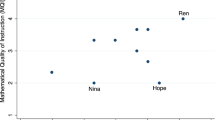Abstract
Patriot High School (PHS) adopted a remediation strategy to help its 10th-grade students at risk of failing the Math portion of MCAS, the state’s end of year competency exam. The centerpiece of that strategy was a computer-based instructional (CBI) course. PHS used a commercially available CBI product to align the course content with the competencies covered on the MCAS exam. This case study examines the overall effectiveness of the PHS strategies, and in particular, the role of CBI. Participant MCAS scores and CBI performance (measured by module-mastery data) are analyzed, and an interview with the course instructor is summarized. Finally, PHS scores were compared to the overall state MCAS scores for the same years. Overall scores of all 10th graders increased significantly compared to their 8th-grade scores, students who participated in the CBI course improved more than the students who did not. The passing rate at PHS improved from 40% in 1999 to 84% in 2001, compared to an improvement of from 47% to 75% statewide. A significant correlation was identified between the MCAS scores and the program usage data, with student CBI module mastery correlated with higher MCAS scores. Overall, the instructor was positive about the impact of the course and believed that the course gave many under-performers a chance to succeed when more traditional methods had failed. It seems likely that CBI contributed to PHS’s success. Although we report herein on just one case, we argue that CBI might play an important a role in the high stakes test environment in the USA and eleswhere.


Similar content being viewed by others
Notes
The discrepancy between this average scale score (237) and the average score calculated in the earlier analysis (239) is that the latter does not include all students; it only includes students for whom 8th and 10th grade scores were available. Of the 146 PHS students who took the exam (and are included in Table 2), 126 students were included in the earlier analysis.
Note that Table 3 includes a category for the % of student who failed. The number of students who passed is the sum of the Advanced, Proficient, and Needs Improvement categories.
References
Clark, R. E. (1983). Reconsidering research on learning from media. Review of Educational Research, 53(4), 445–459.
Clark, R. E. (1994). Media will never influence learning. Educational Technology Research and Development, 42(2), 21–29.
Cuban, L. (1986). Teachers and Machines: The Classroom Use of Technology Since 1920. New York: Teachers College Press.
Foshay, W. R. (1998). Instructional philosophy of PLATO, Tech Paper #3. Bloomington, MN: PLATO Learning, Inc. Available at http://www.plato.com
Foshay, W. R. (2000). Instructional models: Four ways to integrate PLATO into the curriculum. Technical Paper #6. Bloomington, MN: PLATO Learning, Inc.
Hannafin, R. D. (2002). Study on the effect of PLATO-supported instruction on NC competency test results of one NC high school. Unpublished evaluation report available at http://www.plato.com
Hannafin, R. D. & Oppenheimer, D. (1999). Study on the effect of PLATO-supported instruction on standardized test performance and on the graduation rate of one Oregon high school. Unpublished evaluation report available at http://www.plato.com
Hess, F. (2000). None of the above: Promise and peril of high stakes testing. The American School Board Journal, 187(1), 26–29.
Jonassen, D. (2000). Computers as mindtools for schools: Engaged critical thinking. Upper Saddle River, NJ: Prentice-Hall, Inc.
Kinzie, M., Sullivan, H., & Berdel, R. (1992). Motivational and achievement effects of learner control over content review within CAI. Journal of Educational Computing Research, 8(1), 101–114.
Kulik, J., Kulik, C., & Bangert-Drowns, R. (1985). Effectiveness of computer-based education in elementary schools. Computers in Human Behavior, 1, 59–74.
Kulik, C., & Kulik, J. (1991). Effectiveness of computer-based instruction: An updated analysis. Computers in Human Behavior, 7, 75–94.
Kozma, R. (1994). Will media influence learning? Reframing the debate. Educational Technology Research and Development, 42(2), 6–19.
Means, B., & Olson, K. (1995). Technology’s role within constructivist classrooms. San Francisco, CA: Paper presented at the annual meeting of the American Educational Research Association.
Papert, S. (1980). Mindstorms: Children, computers, and powerful ideas. New York: Basic Books, Inc.
Seymour, S., Sullivan, H., Story, N., & Mosley, M. (1987). Microcomputers and continuing motivation. Educational Communication and Technology, 35(1), 18–23.
Sivin-Kachala, J. (1997). Report on the effectiveness of technology in schools, 1990–1997. Software Publisher’s Association.
Swenson, R., & Anderson, C. (1982). The role of motivation in computer-assisted instruction. Creative Computing, 8(10), 134–139.
Author information
Authors and Affiliations
Corresponding author
Rights and permissions
About this article
Cite this article
Hannafin, R.D., Foshay, W.R. Computer-based instruction’s (CBI) rediscovered role in K-12: An evaluation case study of one high school’s use of CBI to improve pass rates on high-stakes tests. Education Tech Research Dev 56, 147–160 (2008). https://doi.org/10.1007/s11423-006-9007-4
Published:
Issue Date:
DOI: https://doi.org/10.1007/s11423-006-9007-4




